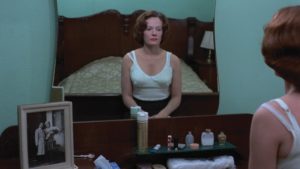The esteemed film magazine Sight and Sound, which is published monthly by the British Film Institute, released its once-a-decade list of the 100 greatest films of all time on Dec. 1. First published in 1952, the list is currently the product of a poll of 1,600 critics — and the results are at once startling and reassuring.
Most significant are the inclusion and rise in rank of films directed by women and Black people. What is reassuring is that, in many ways, the list remains a basically conservative estimation of the canon — though now, new and different films are part of it.

The most newsworthy development is the ranking of Chantal Akerman’s 1975 experimental feminist epic Jeanne Dielman, 23, quai du Commerce, 1080 Bruxelles in first place. The film has risen dramatically: in 2012 it was 36th on the list, and in 2002 it was 73rd.
Akerman, a Belgian Jewish lesbian and the daughter of Holocaust survivors, made the film at age 25. When it was first released, it was recognized as a daring, revelatory work: a three-hour-and-22-minute procedural of a prim, widowed Brussels housewife, played by Delphine Seyrig, doing her daily chores. She shops, chops, cooks, cleans, and, most pointedly, turns tricks in the afternoon for quick cash when her teenage son is at school. (The film’s title is the address of her apartment.) It was hailed at the time by critics including J. Hoberman of the Village Voice — Akerman had been a part of the downtown New York film scene in the early ’70s — but it never reached multiplexes or mainstream art houses and mostly remained an academic favorite.
The works that Akerman directed later never rose to the same level of acclaim, though her 1976 feature News From Home, which depicts scenes of New York as Akerman reads letters from her mother in Belgium, is No. 52 on the 2022 Sight and Sound list. In 2015, having suffered from deep depression after her mother died, she took her own life at age 65. That same year, I screened Jeanne Dielman as part of the Provincetown Film Art Series at the Waters Edge Cinema, and it was greeted enthusiastically. It is undeniably an important achievement and a surprisingly accessible film.

But I think it’s overreaching to claim it as the greatest film of all time. That’s the understandable reaction of a younger generation of film scholars to the history of sexism and racism in the cinema, both onscreen and behind the scenes. Women were rarely given the opportunity to direct films until recently, and when they did, their work was often not taken seriously. The same is true of Black filmmakers. This is changing, as the film industry reluctantly adapts to the demands of diversifying talent and audiences. The Sight and Sound poll is a wake-up call to the critical establishment and its longtime orthodoxies.
And it’s a wide-ranging wake-up call at that. Beau Travail, Claire Denis’s visually poetic 1998 adaptation of Billy Budd in a contemporary French foreign legion boot camp, is now ranked seventh, up dramatically from No. 78 in 2012. Two films by the recently deceased Agnès Varda have arrived on the list: Cléo From 5 to 7 (No. 14) and The Gleaners and I (No. 67). Also appearing for the first time: Daisies (No. 28), an upstart female buddy movie by Czech director Vera Chytilová; Portrait of a Lady on Fire (No. 30), a period lesbian romance by Céline Sciamma; Barbara Loden’s Wanda (No. 48); Jane Campion’s The Piano (No. 50); and Daughters of the Dust (No. 60), Julie Dash’s impressionistic view of Gullah women on the South Carolina coast. They’re all worthy choices, particularly Beau Travail, Cléo From 5 to 7, Portrait of a Lady on Fire, and The Piano, but their rank and inclusion give them outsize importance.
The films of Black directors from the U.S. and Africa, which have been criminally underrated by mainstream critics and the Oscars, have also been added and raised in rank, as well as Asian films and those with queer subject matter. Spike Lee’s Do the Right Thing is No. 24; the Oscar winner Moonlight, an extraordinary Black queer coming-of-age story directed Barry Jenkins, is No. 60; and Jordan Peele’s horror flick Get Out is No. 95. The Oscar winner Parasite is No. 90, giving Korea representation, and two animated films from Japan by director Hayao Miyazaki are included for the first time.
To make way for this surge of newcomers, the current list loses three films by Ingmar Bergman (Wild Strawberries, The Seventh Seal, and Fanny & Alexander) and two by Orson Welles (The Magnificent Ambersons and Touch of Evil) as well as such classics as Chinatown, Nashville, Grand Illusion, and Rio Bravo — all of which were on the previous list in 2012.
Are these omissions crazy? Perhaps, but lists are a bit arbitrary, as is the evaluation of art. Great work is always in the eye of the beholder to some extent, and, as times change, so do our judgments of what is a masterpiece. How we rate things is largely a mirror of our current ethos and aesthetic trends.
Still, I believe that there is merit in polling the opinions of experts — people who have studied and are passionate about the cinema — and there is an honest purpose in defining a canon of great works. Rankings can be silly and so can awards contests, but there is something valuable in comparing movies side by side on a vertical scale. You get a greater understanding of their timelessness and their stature within the totality of the medium.
That’s why it’s reassuring to see that many of the usual suspects — from Hitchcock’s Vertigo, North by Northwest, and Psycho to Welles’s Citizen Kane; from Buster Keaton’s The General to Jean Renoir’s The Rules of the Game — are still there. It doesn’t hurt them to be judged against new and different work. In time, all the rash decisions will balance out.
To see the full Sight and Sound 2022 list of 100 films, visit bfi.org.uk/sight-and-sound/.



